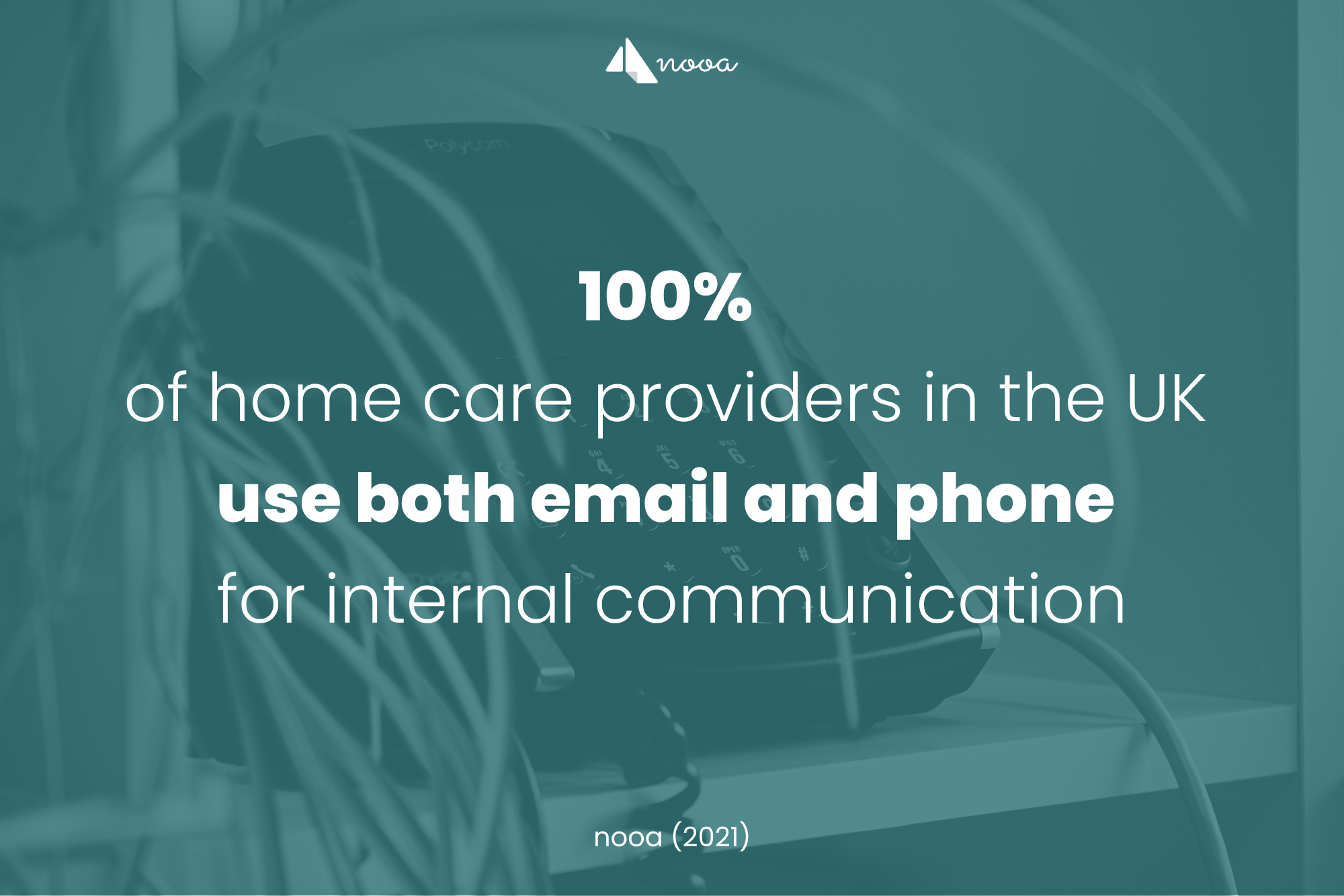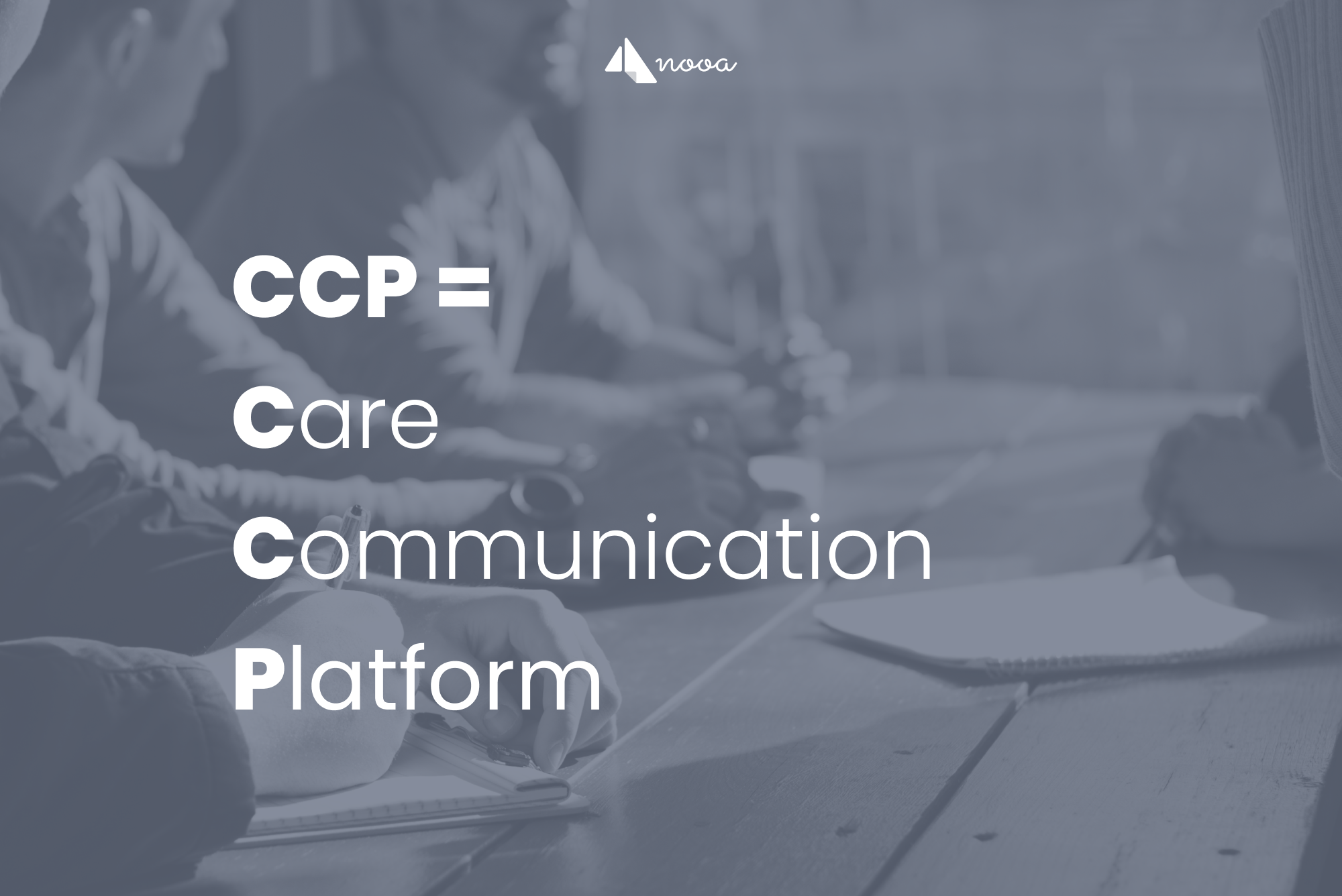How to set your frontline workers up for success
Why is it important and how do you set your frontline workers up for success? We share our perspective and top tips.
Despite the digitisation of care, most providers have yet to adopt communication strategies that correspond to modern expectations.

Streamlining communication and coordination was recently nominated as one of the top three trends in healthcare that will continue to influence investments and decision-making in 2022.
Healthcare is an interdisciplinary field with many stakeholders. The coordination of care around a client is a complex task that requires not only hands-on-management, but in particular seamless and effective communication with employees and colleagues across organisations, clients and their families. Especially in home care, there is a constant need to communicate around clients and admin. Information may not always be as urgent compared to clinical settings, but it is equally important due to the high frequency of repetitive tasks and the relentless need to coordinate across time and space.
Poor communication costs a lot of time and money. Even worse, it leaves staff strained and unhappy, increasing turnover, and clients unsatisfied with the service they receive. In summary, efficient communication is critical for the success of every home care provider.
This article shows you the problem and offers the solution.
Most providers still depend on phone calls, emails and paper. However, we are beginning to understand that these one-way means of communication are ineffective and inefficient, resulting in errors, frustration, delays and bottlenecks.
Due to the large coverage areas of providers and the dynamic nature of home care, it is a big challenge to keep all staff informed. This includes communication between the office and the field as well as in the field between home care staff. In addition, the same information often has to be shared with different people, with emails, team meetings and paper being put to use haphazardly.
The phone is very popular - a leader in “synchronous communication” tools. This real-time exchange of information can be very time-consuming and stressful, especially for mobile workforces. When out and about, availability can be bad and numerous attempts have to be made to reach someone. The caller may have to leave voicemails without knowing if the message will reach the person on time. In addition, information cannot be traced backed or looked up at a later point in time, increasing errors and stress amongst staff. Calling is justified in some cases, during emergencies or to share urgent information quickly, but the cost for communicating non-urgent information on a daily basis is simply too high.
Emails, in contrast, rank high when it comes to “asynchronous communication” tools. Using emails confronts users with a different set of problems: information is isolated, group communication is chaotic and specific information can be very hard to find. People have to go through long email chains to gather relevant information. When someone replies to an email chain, all recipients are addressed, even if it is not relevant for them, or worse, relevant addressees are left out. Moreover, urgent information often arrives too late via email, or is drowned out by the noise of a full inbox.
We recently conducted a survey with a large number of social care providers. Every respondent confirmed the use of both phone and email to communicate internally, especially to share information around admin.

To summarise: neither phone nor emails are suited to help home care providers share information in a way which helps them do their job efficiently. The aforementioned tools serve a specific purpose and are only effective in niche situations - however, unable to share information quickly and reliably with staff and clients, they are limited, outdated and not flexible enough to fit the needs of home care.
In order to overcome the limitations of phone and email, organisations often introduce a messenger.
As of October 2021, two billion users were accessing WhatsApp on a monthly basis, making it by far the most popular mobile messenger application. Although an asynchronous tool like email and fax, most users perceive and use WhatsApp as a synchronous communication tool. In care, many companies frequently use WhatsApp to communicate with peers. However, with WhatsApp, healthcare workers face two major problems.
The first problem is that WhatsApp does not comply with GDPR regulations. Given the non-compliance with GDPR, using it puts healthcare workers at risk to make errors when managing client data. The safety of sensitive data cannot be guaranteed since it is stored locally on the device where it is used and there is no central access control and management. This makes it impossible to centrally recover and delete data.
Another issue is that the option to delete messages prevents effective auditing. Worse still, WhatsApp accounts are often used for private and work-related communication, exacerbating compliance issues. Home care organisations often try to circumvent these problems by introducing workarounds, for example obfuscating, abbreviating or codifying data to avoid unique identification of clients. While this usually creates confusion and misunderstanding, it does not solve the issue: having to share images, with which accompanying metadata such as date, time or geographical coordinates is transmitted, again leads to compliance issues that are not solved with workarounds.
Besides WhatsApp, many other messaging applications exist. Some of them face the same issues, lacking GDPR compliance, while others comply with regulations. But why have these not been adopted in care settings?
Here, we encounter the second problem: messengers are not suited for communication in care. One of the issues users face with messengers concerns group chats. Since these are usually unstructured and undisciplined, individuals have a hard time following-up on information they require, since the stream of conversation has left them behind. In addition, they are cluttered with things that do not concern them, resulting either in information overload or in leaving the group. In both situations, recipients do not get the information they need, when they need it.
Since information in care can be a matter of life and death, it needs to be both structured and targeted - a requirement that conventional messengers do not meet. In addition, most messengers are not portable and can only be used on one device. This is often further limited to use on a single mobile device, without access from a PC or tablet, making it impossible for care workers to work from multiple bases and locations. To summarise, even secure messengers do not meet the requirements of care communication to an extent where the costs justify the benefits.
So what about care software? Good question. Some care software solutions have one or multiple communication features integrated somewhere in their systems. While these systems are adapted to home care needs, communication is not their primary use case. Compared to phone calls, emails and messaging, users are unable to communicate with care software in the same way. This paradigm shift forces everyone to learn new ways of sharing information, making them a lot less efficient. To make matters worse, most communication features in care software are very limited, usually reduced to basic one-to-one text messages, making group communication and media sharing impossible.
Furthermore, these systems are siloed and cannot properly connect staff to the people they need to be connected to, for example GPs or nurses, which use systems of their own. This leaves healthcare providers with disjointed systems, forced to bridge the information gap with phone, email & co. Common shortcomings are:
In addition, care software-based messaging can be cumbersome, consuming a large part of the IT budget and failing to scale across the organisation. Software providers often struggle to support urgent and emergent communication, and most do not offer the feature-rich communication tools that care teams need to collaborate effectively.
Given the shortcomings of care software when it comes to communication, many providers still use unsafe messengers or outdated technology to share information with their teams or with other care providers.
From the myriad of tools that we have discussed, not one of them meets the requirements that home care providers need. As a result, providers use a combination of old, ineffective and time-consuming tools, leaving them with a patchwork communication system. Inevitably, this patchwork is inefficient and insufficient, forcing staff to resort to an unreasonable amount of meetings and conversations, exchanging details that should have been shared with a click of a button.
But what is the solution?
The temptation to fall back to old habits or squeeze a functionality in existing software is usually overwhelming, so even though the solution is straight-forward, it is anything but obvious.
Care communication platforms (CCPs). These are integrated solutions that are designed to enable communication between care workers, including office, field and at-home staff, as well as with partners outside the own organisation, including clients and their families.

CCPs have experienced a surge in popularity for good reason. Not only can they help improve communication amongst care teams, but they can also lead to time and cost savings, better collaboration between departments, and better client care. Other benefits that are frequently reported include: improved communication and streamlined workflows, reduction of phone tag, decreased consultation time and a more collaborative work environment to improve the level of care provided to clients.
It is important to note that CCPs are not meant to replace care software, but to enhance it. They bridge the gap in communication by connecting key staff, making client data actionable, and effectively merging data into a single solution.
Even though the range of functionalities differ, CCPs are meant to not only improve care collaboration but also to engage clients. They provide secure, GDPR-compliant communication for care providers that need fast response times and seamless care coordination. By enabling quick and protected exchange of information between all members of a client’s care team, including the client themselves, secure CCPs, that usually include an enterprise messaging application out of the box, enable high-quality and efficient care. In particular, when a client relies on home care, CCPs provide a quick, secure and compliant way for the home-based care team to coordinate with nurses, GPs and other care staff, as well as the client and client’s family.
When choosing your CCP, there are a few key things to look out for:
What it comes down to is finding solutions with which we can improve our homecare system and improve care for our clients. The fastest and easiest way to do this is to have meaningful adoption of connected communication systems to drive improvements in cost, quality and care experiences.
CCPs are the tool with which we can achieve this. Luckily, they are very low cost, especially compared to the obvious benefits they bring, can be implemented quickly, and deliver results from day one. With a viable alternative at your fingertips, the time of inefficient and insecure patchwork communication in care is finally over.
Why is it important and how do you set your frontline workers up for success? We share our perspective and top tips.
Everyone is involved in at least one of these during their career - whether as a manager, project leader or user. You guessed it: IT projects.
Everyone is talking about the digital workplace. In our hands-on article, you'll learn how to use digital solutions profitably.
Subscribe to our free magazine to receive automatic notifications whenever a new article is published.